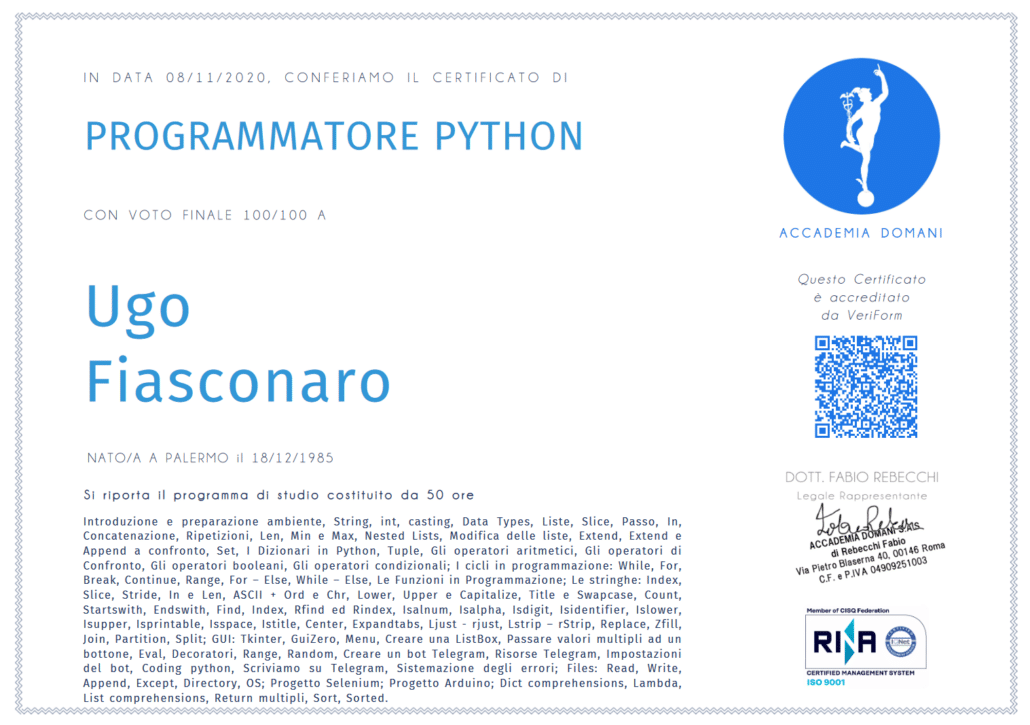Python Developer – Lead Python Programmer

Python Developer – Lead Python Programmer
Ugo Fiasconaro – Expert in the world of Coding I develop Python RPA processes, I am a Lead Python Developer.
Introduction and preparation of environment, String, int, casting, Data Types, Lists, Slice, Step, Concatenation, Repetitions, Len, Min and Max, Nested Lists, Editing of lists, Extend, Extend and Append Comparison, Set, I Dictionaries in Python, Tuple
In the world of Python programming, it is essential to understand the basic concepts such as strings, whole and casting. Management of different types of data is essential to ensure an efficient and functional code. Lists and slices offer the possibility to organize and manipulate data in creative ways, allowing programmers to work more flexible.
Passing to the practical phase, step-by-step use in the Python language allows iteration through a sequence with modularity and precision. The operator is indispensable to verify the belonging of an item to a list or any other data structure. In addition, string concatenation opens new perspectives in the context of dynamic text creation within programs.
Arithmetic operators
The arithmetic operators in Python are fundamental tools for performing mathematical operations on numbers. From simple amounts and subtracts to more complex multiplications and divisions, these operators allow the programmer to manipulate data efficiently and accurately. Moreover, through the use of operators such as % (module) you can get the rest of a division, useful in different situations to control the parity or calculate repeated cycles.
Comparison operators
By switching to comparison operators, they are used to comparing values and returning boolean results. An interesting aspect to consider is that these operators are not only limited to verifying the equality between two values, but also allow comparing them according to the order (more, less or equal). This feature offers the programmer a wide margin of maneuver in managing the conditions within its code.
Boolean operators and conditional operators
Empowering the use of Boolean operators in the decision-making structures of the Python program, it emerges their importance in determining the flow of execution according to the specified conditions. The combined use of logical operators such as and, or and not allows you to create complex conditions and process instructions flexibly. Thanks to this versatility, the Python programmer can implement sophisticated decision-making logic, ensuring accurate control over software behavior.
The programming cycles: While, For, Break, Continue, Range, For – Else, While – Else, Functions in Programming.
Programming is based on fundamental concepts such as cycles, which allow you to repeatedly perform an instruction block. Among the most common we find the While cycle, which continues to execute the code until the specified condition becomes false. The For cycle is useful for iterating on a sequence of elements and can be combined with the Range function to specify a range.
In the writing of the code, the Break and Continue instructions are also important. The first allows you to immediately stop the execution of a cycle if a certain condition occurs, while the second jumps at the next step of the iteration without completing the rest of the code within the cycle. Finally, using For – Else and While blocks – Else adds flexibility to the flow control in the code, allowing you to perform specific actions at the end of the cycles according to the conditions defined. The functions play a key role in the subdivision of the code into organized and reusable blocks, making programming more efficient and modular.
The strings: Index,Slice, Stride, In and Len, ASCII + Ord and Chr, Lower, Upper and Capitalize, Title and Swapcase, Count,Startswith, Endswith, Find, Index, Rfind and Rindex, Isalnum, Isalpha, Replacement, Isidentifier, Islower, Isprintable, Isspace, Istitle
Strings are a fundamental element in Python programming, and knowing the various operations that you can perform on them can make the difference in efficient and clean code writing. The use of indexes to access the individual characters of a string, as well as the use of slices to obtain specific substrings, are very useful techniques that allow a detailed management of data.
The manipulation of strings through methods such as lower, upper and capitalize allows you to uniform the text format in an elegant and precise way. In addition, the ability to count how many times a given substrand appears within a longer string with the count method or verify the beginning or end with startswith and endwith expands the potential in data processing. Finally, use the ascii functions to obtain the ASCII code corresponding to a character or conversion between characters with ord and chr represent additional valuable tools in advanced string management in Python.
GUI: Tkinter, GuiZero, Menu, Create a ListBox, Switch multiple values to a button, Eval, Decorators, Range, Random, Create a Telegram bot, Telegram Resources, Bobot Settings, Coding Python, We write on Telegram, Error Accommodation; Files: Read, Write, Append, Except, Directory, OS; Selenium Project; Arduino Project; Dict comprehensions, Lambda, List comprehensions, Multiple Returns, Sort, Sorted.
Today we want to talk about some interesting features in the world of Python programming. We start exploring the creation of a GUI using libraries such as Tkinter and GuiZero, which make the design of intuitive and accessible graphic interfaces. A particularly useful feature is the ability to create ListBox to display lists of options in an orderly and interactive way.
We then discuss the passage of multiple values to a button, an operation that may seem complex but becomes more manageable with the use of Eval functionality in Python. We will also deepen the use of decorators to optimize the code and make it more efficient, along with the importance of using Range and Random modules to generate random numbers in a controlled manner. Finally, we will explore how to create a Telegram bot to automate processes and communications, opening up new creative opportunities in Python programming. The world of coding is vast and exciting, rich in tools like Risor that make it possible to transform ideas into reality with ease.

